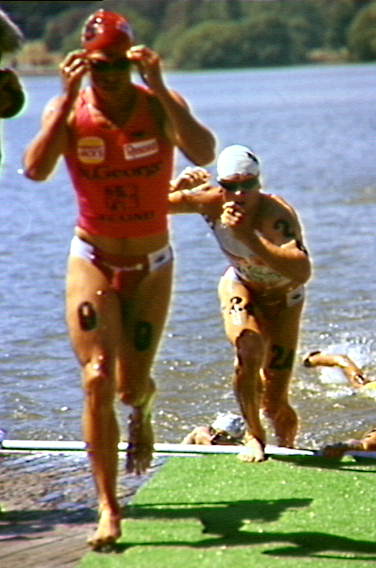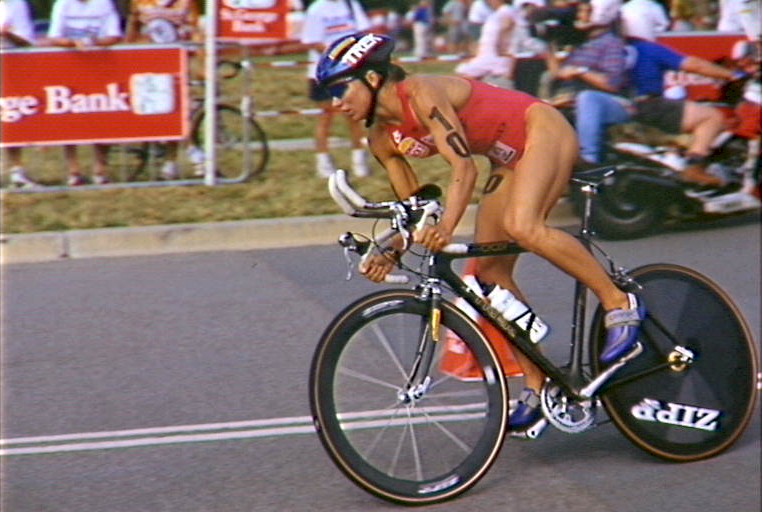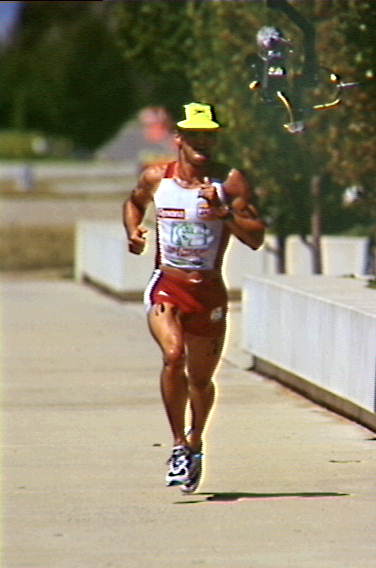 | ||
 |
||
|
| ||
 |
|||||||||||||||||||||||||||||||||||||||||||||||||||||||||||
Triathlon Characteristics of triathlon Overview Triathlon, as the name suggests involves the combination of three separate exercises - swimming, cycling and running. The order of events is usually swim, cycle, run although some professional sprint triathlons vary this order. Triathlons are completed over various distances ranging from 1 hour events to all day races. The table below outlines the various distances over which triathlons are completed.
AIS Triathlon Triathlon is a new sport to the Australian Institute of Sport and is based jointly between Canberra and the Gold Coast. The current team consists of junior male and female competitors preparing for elite junior competition including the World Triathlon Championships. Athletes are 20 years old or younger and are selected on their performances in Australian olympic distance races held around the country. To find out more about the Australian Institute of Sport Triathlon program visit the AIS Triathlon website Training As triathletes range from full-time professionals to age group competitors, the time spent training varies considerably. Since there are three disciplines to master, most triathletes train twice each day to make sure all disciplines are trained regularly. Athletes will routinely combine disciplines into the one session to ensure their bodies are well adapted for the stresses of competition. These sessions are commonly called "brick sessions" and usually involve two or more of the disciplines. For professional triathletes, it is not uncommon to train two to three times daily, with some professional ironman triathletes clocking up as many as 40 hours of training a week. Special considerations In most triathlons, drafting (riding directly behind or beside a fellow competitor) during the cycle leg is prohibited as this provides a 10-15% advantage to the athlete drafting. The only exception to this rule is for professional sprint and olympic distance competitors, where drafting is legal. This "drafting permitted" ruling tends to impact heavily on the physique of the athletes who are successful at these distances. As much of the advantage of being a strong cyclist is lost in sprint and olympic distance races, many successful triathletes at these distances have physiques similar to runners, that is light and lean, which enables them to run quickly. However, ironman triathletes tend to be more strongly built as the cycle plays a crucial role in determining the outcome of the race. Common Nutrition Issues Daily recovery Routine training loads for elite level triathletes increase daily energy (kilojoule), carbohydrate and protein requirements. Many triathletes in the past have focused exclusively on replacing carbohydrate at the expense of other nutrients such as protein. It is important for triathletes to ensure meals and snacks are based around nutritious carbohydrate foods to meet daily fuel and nutrient demands. Persistent fatigue, poor recovery, illness, and unwanted weight loss are common amongst triathletes who fail to adequately meet daily energy and nutrient requirements. Timing of meals and snacks around training sessions As triathletes are required to train 2-3 sessions each day, recovery from one training session to the next is crucial to maximise training gains. Triathletes need to plan their daily food intake to ensure regular snacks and meals are consumed around training sessions. It is important to have nutritious carbohydrate snacks on hand immediately after training to initiate the refuelling process. The following snacks are examples that provide sufficient carbohydrate to optimise recovery: Male athlete (target 60-80 g carbohydrate)
Female athlete (target 40-50 g carbohydrate)
Note: * indicates a valuable source of protein/amino acids in addition to carbohydrate Carbohydrate loading The concept of carbohydrate loading is popular amongst triathletes prior to competition. Carbohydrate loading is more than simply eating pasta for dinner the night before competition and certainly doesn't mean gorging yourself with food for the entire week leading into a race. As your training decreases leading into a race, energy (kilojoule) and carbohydrate requirements also decrease. During an easy week prior to competition it is important to taper your food intake accordingly to avoid unwanted weight gain immediately prior to racing. To adequately fill muscle glycogen (carbohydrate store in the muscle), athletes need to consume between 7-12g of carbohydrate per kilogram body weight for 24-48 hours prior to competition. The length and total amount of carbohydrate consumed by an athlete will depend largely on the length of the triathlon to be competed. For sprint and olympic distance competitors the taper in training leading into the race in conjunction with 7-10g of carbohydrate per kilogram body weight for 24 hours before competition is adequate to increase muscle glycogen stores. However, athletes competing in half ironman, long course and ironman races should increase their carbohydrate intake to 10-12 grams of carbohydrate per kilogram body weight for 48 hours before race start. This will allow the muscles to maximally load with glycogen prior to race start which will help off-set fatigue. A 70kg athlete competing in an olympic distance triathlon should aim to consume 490-650 grams of carbohydrate on the day before a race. An example meal plan is outlined below. It is important to recognize the use of carbohydrate rich, low-fat, easily digested, low bulk foods and fluids. The essence of carbohydrate loading is to increase your carbohydrate intake, not your intake of other nutrients namely fat. Sample carbohydrate loading plan for a 70kg Olympic distance triathlete
This sample carbohydrate loading meal plan provides roughly 14,200 kJ, 590 grams of carbohydrate, 125 grams of protein and 60 grams of fat. Pre-race eating The majority of triathlons start early in the morning so there is the temptation to miss breakfast before race start. It is crucial to eat a pre-race meal in order to top up muscle and liver glycogen stores prior to race start. A pre-race meal containing roughly 2 grams of carbohydrate per kilogram body weight should be consumed roughly 2 hours before racing. The meal should contain familiar carbohydrate rich foods and fluids that are low in fat and fibre. For instance two English muffins, 1.5 tbsp of jam, 1 tsp vegemite and 750 ml sports drink provides 2500 kJ, 125 grams of carbohydrate, 2 grams of fat, 14 grams of protein and only 4 grams of fibre. Foods like liquid meal supplements, sports bars, bananas and juice are also popular pre-race meal choices. If you have the early morning jitters liquid meal supplements such as Sustagen Sport provide an easily digested alternative to foods. It is also worthwhile to sip on water or a sports drink during the hour before race start to top up fluid levels. The advantage of competing in triathlons is that you can always urinate during the swim if you drink too much beforehand. Eating during training and competition Eating food during long training rides is essential for triathletes to help provide carbohydrate to the working muscles, meet daily energy and nutrient requirements and keep hunger at bay. Most ironman triathletes complete "brick" sessions during their preparation for an ironman triathlon. Brick sessions may consist of a 5-6 hour cycle immediately followed by an hour of running. Eating during brick sessions is not only beneficial, but essential. During sprint and olympic distance triathlons it is not necessary and certainly not practical to eat foods while racing. Due to the high intensity of racing, athletes competing in these events usually rely exclusively on sports drinks and sports gels to meet fuel and fluid losses. However, during ironman races where athletes are competing over several hours and consequently miss regular meals, eating food plays an important role in meeting their hourly carbohydrate requirements. Triathletes need to consume roughly one gram of carbohydrate per kilogram body weight for each hour of exercise. This is roughly 60-70 grams of carbohydrate each hour for most triathletes. Ironman triathletes should be encouraged to think of the bike leg as a 'rolling buffet' because they really need to consume adequate fuel and fluid during this discipline to set themselves up for the run. The cycle presents the greatest opportunity to consume adequate food and fluid, compared to the run and swim. Athletes should take a variety of food on the bike to ensure they maintain interest in what they are eating. Sandwiches (white bread, no marg, with crusts cut-off), fruit bars, sports bars, bananas, sweet biscuits, dried fruit and sports gels are all examples of foods commonly eaten by triathletes while cycling. It is good practice to have a combination of regular food items and sports foods. The run presents many more challenges than the bike in meeting carbohydrate requirements. Most triathletes use fluids such as sports drinks and coca cola to simultaneously meet fluid and carbohydrate requirements during the run. During ironman events athletes will also use sports gels as these are far more practical to consume than food while running. Meeting fluid requirements during training and competition As triathletes are required to train 2-3 times each day sweat losses tend to be high, particularly when training in warm environments. Athletes need to make a conscious effort during the day to adequately replace fluid losses or run the risk of chronic dehydration. Having access to a drink bottle during training and carrying a drink bottle around during the day is key in ensuring athletes meet daily fluid losses. Dehydration is the most common cause of medical treatment following triathlons, despite race organisers providing fluids during the cycle and run legs. Athletes should aim to consume a minimum of 750ml of fluid each hour during the cycle leg, as the cycle provides the greatest opportunity to match sweat losses. It is difficult to consume while running, particularly when racing at pace so athletes need to be mindful of the importance of drinking while cycling. Weight management As with most endurance-based athletes, triathletes commonly strive to achieve a low body fat level in order to improve their power to weight ratio. This fascination with weight loss amongst triathletes has led to the popularity of so-called high protein, low carbohydrate diets. These diets are low energy (kilojoule) diets and decrease body weight not because of the combination of nutrients but because they are low in energy. Athletes following such diets to lose weight run the risk of failing to recovery from training and compromising their immune system function. Travel to overseas countries Professional triathletes are required to spend several months each year competing in Europe, Asia and the United States of America. This can create numerous problems for the unsuspecting triathlete. Most triathletes travel alone so they don't have the support of a team Dietitian to arrange meals ahead of time. Some carbohydrate rich foods readily available in Australia such as breakfast cereals, sports bars, sports gels, and sports drinks, along with fruit and vegetables are scarce and/or expensive throughout Europe and Asia. Prior to departure, it is a good idea to pack a small supply of favourite foods such as breakfast cereals, breakfast bars and liquid meal supplements, along with specialised foods items such as sports bars, sports gels and sports drinks.
You will find more information about triathlon at the
Australian Institute of Sport on the
|
| ||||||||||||||||||||||||||||||||||||||||||||||||||||||||||
|
The Department of Sports Nutrition is a program of the
Australian Institute of Sport General enquires can be emailed to: aisnutrition@ausport.gov.au Copyright
© Australian Sports Commission
| |||||||||||||||||||||||||||||||||||||||||||||||||||||||||||



